· 12 min read
In this first article, I described how climate change is a symptom of a systemic and multifactorial sustainability crisis resulting from human behavior patterns.
In a second article, we explored what generated these patterns and how primal survival mechanisms deeply embedded within the collective unconscious have become self-destructive in the context of exponential technological progress characterizing the Anthropocene. We have also highlighted how these primal survival strategies are perpetuated by social structures established on collective beliefs, fears, and traumas inherited over humanity’s history.
This article, which is based on an understanding of the problem and its hidden root causes, will propose solutions that treat the root causes of the problem together with a “realistic” path to achieving the much-needed sustainable transition on a planetary scale successfully.
Addressing the first obstacle on the path to change: our collective state of denial of the problem and its fundamental causes
We cannot solve a problem that we refuse to face, and a global and systemic crisis of sustainability is a problem that we need to face collectively on a planetary scale.
It is not just awareness about climate change, growing inequalities, or ecosystem destruction that is needed, but an understanding of the interrelations between all these issues and their fundamental causes: obsolete systems and unviable human behavior patterns. In other words, these external issues we are trying to address stem out of internal issues that we haven’t even started to seriously acknowledge yet. As long as we remain collectively in denial of the systemic and multifactorial crisis of sustainability and its hidden root causes (within us), we won’t have the needed level of understanding to resolve it.
As such, massive awareness campaigns are needed for people to recognize that the crisis we face requires an evolution of our relationship with ourselves, one another, and the natural world.
Facing an hyperobject like a planetary scale sustainability crisis requires the development of our emotional and mental maturity. Denying what is happening on the surface of the globe and within us is a skillful response to protect the psyche from getting destabilized by thoughts and emotions (cognitive dissonance) that are too disturbing and overwhelming to meet without capable support. In a way, the sustainability crisis obliges us to face parts of reality and ourselves that we have rejected, repressed, and ignored until now. This collective shadow includes unresolved wounds, irrational fears, and false beliefs that we haven’t found the courage to face yet. Creating safe spaces, practices, and tools for people to engage in these sensitive conversations and process whatever will be triggered within themselves is critical.
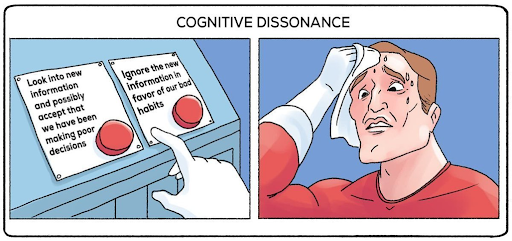
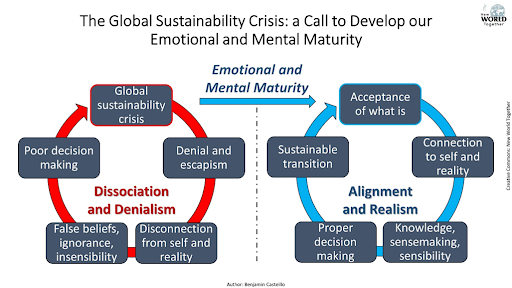
Breaking the vicious cycle of primal survival keeping humanity in a self-destructive egoic paradigm
As we have seen in the previous article, we are still living in a paradigm of fear and survival in which the dominant social norm is still to:
- respond to the danger of hostility by trying to dominate and neutralize rivals
- respond to the danger of scarcity by accumulating always more possessions and wealth
- respond to the danger of separation by rejecting ourselves to conform to social norms
These accepted social norms perpetuate a vicious cycle of violent conflicts, resource overconsumption, and separation that is increasingly dangerous and unsustainable in the context of exponential technological progress. They are perpetuating the threats of hostility, scarcity, and separation keeping our species in a state of fear, prisoner of increasingly unsustainable primal survival strategies.
To stop these vicious cycles, we have to learn individually and collectively:
- to develop our sensibility to be able to resolve our conflicts peacefully (instead of using brute force to dominate our “enemies”)
- to identify and fulfill our real needs to make moderate use of our planetary resources (instead of compulsively hoarding wealth and possession)
- to accept and embrace ourselves as we are to become truthful and authentic (instead of repressing ourselves to follow unviable and toxic social norms)
All of these are interrelated and therefore are part of the same journey toward self-knowledge and self-realization.
Doing so requires an expansion of our individual and collective level of consciousness to:
- Identify the unconscious mechanisms that drive our unsustainable patterns
- Put in the effort and inner work to recalibrate them
- Support others to catalyze the needed change
This is not an easy process, it requires time and investment to go inward and find the courage to meet our unresolved wounds, irrational fears, and false beliefs. Of course, not everyone has the privilege to be in the right condition to start this process of conscious evolution. It is neither fair nor realistic to ask people directly affected by war, oppression, and/or extreme poverty to do the inner work to heal their wounds while they are struggling to survive. Healing can only occur in a safe and regenerative space.
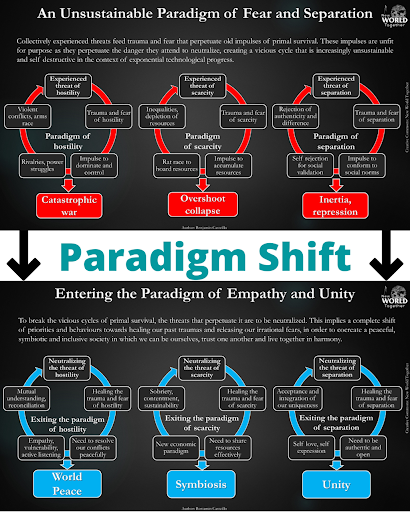
A planetary-scale regenerative transition
We will not fix interrelated global problems if we continue to address them separately and in silos, while ignoring both their interrelation and shared root causes. Addressing these roots means dealing with collective and intergenerational traumas, fears, and beliefs that are embedded within our cultures, societies, and identities.
The path to get there is both easy to understand and challenging to take because it implies finding the courage to face what has been repressed in the collective unconscious until now: the parts of ourselves that carry our biggest fears, and wounds. This is why the first step to the regenerative transition is one of “radical acceptance” of our reality, of ourselves, of our heritage, and our potential futures.
From there we can start to acknowledge and address our individual and collective psychological wounds. Some have already started this process. Thomas Hubl for example is leading entire groups to acknowledge and heal their collective traumas.
More and more people are also starting to recognize the grim past. As an example, Pope Francis has publicly asked for forgiveness for the abuses that Native people have been through in Christian residential schools. We are slowly starting to recognize the colonial heritage that has left deep collective traumas and resulted in the establishment of unsustainable systems of exploitation and extraction all over the globe. Although it is far from enough, these are the first steps toward mutual understanding, reconciliation, and healing.
This process of regeneration on a collective level implies an unprecedented level of post-traumatic growth, an expansion of our level of self-awareness, self-knowledge, and empathy that would generate tremendous changes at all levels of our society. This cultural renaissance established on self-knowledge paves the way towards a new century of light: a shift of paradigm driven by the awakening and expansion of human self-consciousness.

Making our unconscious social structures conscious:
We are the co-creators of the beliefs, narratives, and values that shape our societies and identities. When these are not co-created consciously, they are co-created unconsciously which means that they shape ourselves and our world below our level of awareness. We do not have to remain prisoners of cages of our own unconscious making, especially when these are increasingly unsustainable: we are called to recognize them for what they are, and to liberate ourselves from them.
Self-knowledge leads to awareness of our individual and collective creative power, to shape our society and ourselves. To safely and smoothly achieve a much-desired sustainable transition, the human species is invited to claim its creative power and make a conscious usage of it to reshape its global civilization so that it can support:
- the resolution of our violent past conflicts
- the integration of our planetary limits
- the self-realization of all human beings
Again, our ability to unlock our collective creative power is closely related to our ability to acknowledge and address the collective and intergenerational traumas that maintain us in a state of fear and primal survival.
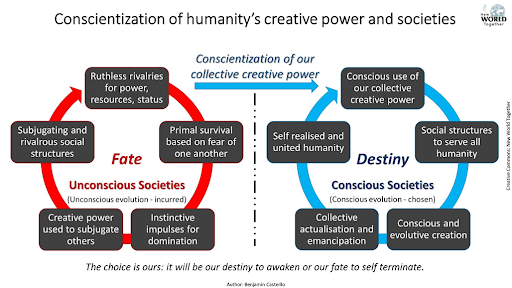
A change of economic paradigm:
Can we integrate our planetary limits within a consumerist and productivist economy based on competition for short-term profits, unlimited accumulation of capital, and growth? The response should not be too hard to answer. Integrating our planetary limits requires a paradigm of collaboration, moderation, and fair repartition not one of competition, excesses, and accumulation.
Our current economic model functions like a hamster wheel in which people have to work more, so they can consume more for the economy to keep growing. It is being maintained through the multiplication of “bullshit jobs” characterized by a lack of real purpose and a negative social and/ or environmental impact.
It is an economic model that can only lead to inequalities, burnout, and ecosystem destruction before it entirely collapses.
The sustainable transition requires a shift of economic paradigm which implies a change in how we measure economic success. We are invited to move away from indicators such as GDP (Gross Domestic Product) which only measures the values of goods and services produced by an economy to replace them with indicators more adapted to the challenges of our times. Indicators that could measure and therefore improve the level of well-being, contentment, and self-realization of a population.
It is also essential to notice that no shift in economic paradigm can occur without breaking free from the old debt-based financial system which artificially manufactures scarcity and perpetuates the need for compulsive growth. Our individual and collective ability to take action will determine whether the unavoidable shift will be forced up our societies or implemented through conscious changes.

A 6 steps process to start the regenerative transition on a global scale
If you had the courage and resilience to read the article until here, you probably felt that all these solutions appear out of reach. This last part is dedicated to offering a pathway so that we can achieve the regenerative transition and the sustainable transformation of our societies in 6 steps from the individual to the collective. Yes, we can… if we want to.
Step 1: Individual awareness – if collective awareness is needed for the human species to achieve a sustainable transition this can’t be achieved without individual awareness in the first place. As such it is up to each and every individual to start educating themselves about the nature of the existential risks of the 21st century, their hidden root causes, and solutions. The key here is to understand that our sustainability problem is to be resolved within ourselves in the first place.
Step 2: Integration – individual awareness is important but if it isn’t embodied then it is as good as someone knowing that they should stop smoking but being unable to do it. Individuals who are aware are invited to go through their inner journey of self-actualization and consciousness expansion. That implies a process of making the dysfunctional part of our unconscious conscious in order to deconstruct the limiting beliefs, release the irrational fears, and heal the unresolved traumas of the past. This could be called a “Journey of the Hero” allowing each individual to unlock their best potential to be part of the solution.
Step 3: Embodiment – once the change is integrated, individuals can incarnate the sustainable transformation. They are the change that humanity needs. These influence people around them and attract other individuals who are engaged in the transition, allowing for collaboration and synergies.
Step 4: Coalition – nobody can catalyze the sustainable transition by themselves. As such, a coalition of actors of change is needed to catalyze the transformation of our society. The key is to act together for this self-consciousness to enter mainstream culture.
Step 5: Popularization – this new knowledge should be represented and discussed in mass media, institutions, and political organizations so that it can inspire and transform the public sphere. Bringing humanity closer and closer to reaching the level of consciousness, knowledge, and empathy needed to start planetary regeneration.
Step 6: Planetary Regeneration – this last step will start when our society is ready to begin the collective healing of the human species. This implies that the earth is now a safe place for people to heal their past traumas, release their irrational fears and deconstruct their false beliefs.
Altogether, the systemic and multifactorial crisis of sustainability faced by the human species is a call for evolution. Just as the caterpillar has to build a cocoon to dissolve itself and turn into a butterfly once it has reached a certain level of maturity, humanity is called to create a safe space to enter the stage of conscious evolution: one in which the human species is not driven by unconscious primal survival mechanisms but by conscious choices stemming out of our collective desire to protect and enhance life. Homo Sapiens (humans who think but don’t understand themselves) are called to become Homo Conscius (humans who are aware of themselves and their creative power).
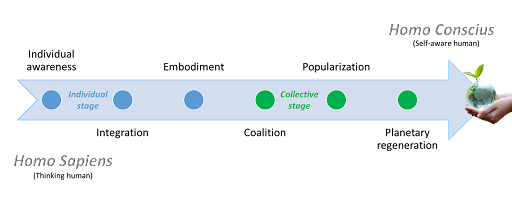
The end to the paradigm of egoism?
The paradigm of egoism, in which we currently live, is established on the false belief or sense that we are somehow separated from each other and the rest of the universe. We now understand that everything in our reality is interdependent and interrelated. As such nothing exists separated from everything else: we are part of a whole in which everything is interconnected. This realization is probably one of the most game-changing in our times. It reveals that protecting and enhancing our environment and protecting and enhancing our lives are the same. It shows that no victory against others and the rest of the world is long-lasting. As such the crisis of sustainability is a call for humans all over the globe to join forces, to safeguard their future.
The existential risks we face as a species are inviting us to move away from a self-perpetuating and increasingly destructive paradigm of rivalry for power, resources, and status to enter a new paradigm of collaboration for emancipation, resource sharing, and realization. The common enemy we are invited to defeat in the 21st century is not Russia, China, or USA (note how it varies very subjectively based on one’s national affiliation), it is the unconsciousness, ignorance, and fears that are keeping us prisoner of an outdated primal survival instinct bringing us o the verge of self-extinction. The cure is not more military power or a bigger economy but an expansion of our collective level of self-awareness, knowledge, and empathy.
And for those who feel that this vision is excessively idealistic, it seems that there are no other realistic and desirable ways forward. The sustainable transition concerns all humanity and requires collaboration on an unprecedented scale and it is not the current paradigm of individualism and competition to get there.
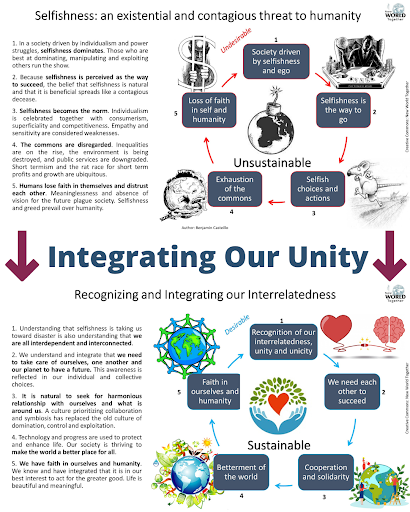
Now more than ever, our future is in our hands and the paradigm shift we are invited to catalyze is to be ignited within each and every one of us. And if we look at the opportunity carried by the great challenges of our times, we may find a beautiful vision for all humanity.
The sustainable transition is our hero’s journey toward the self and unity.
illuminem Voices is a democratic space presenting the thoughts and opinions of leading Sustainability & Energy writers, their opinions do not necessarily represent those of illuminem.






